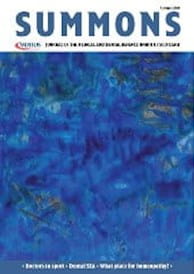AN interest in butterflies formed the rather unlikely basis for one of the 20th century’s most significant discoveries in preventive medicine.
Sir Cyril Astley Clarke’s breakthrough is credited with saving hundreds of thousands of lives since it was first used around 1975 – and it all began with his interest in lepidoptery. The Leicester-born physician and geneticist built on his research into the inheritance of wing patterns in butterflies to eventually develop a method of preventing Rh Haemolytic disease of the newborn.
The life-saving method – which involves administering antibody injections during pregnancy – was developed by Sir Cyril and his team with a little help from his wife Frieda (known as Féo to her family). It was said to have been Féo’s suggestion to inject Rh antibodies – the very things which cause Rh – that proved the key to successfully preventing the disease.
Numerous accolades followed this landmark achievement including a CBE in 1969, a knighthood in 1974 and the Albert Lasker Award for Clinical Medical Research in 1980. Latterly, he was awarded the Linnean Medal in 1981 by the Linnean Society of London and the Buchanan Medal in 1990 from the Royal Society “for his innovative studies on haemolytic disease of the newborn which culminated in new therapies leading to the elimination of this major foetal disease”. He was also president of the Royal College of Physicians while in retirement from 1972 to 1977.
Sir Cyril was born in 1907 and educated at Oundle, Cambridge and Guy’s Hospital where he qualified in 1932. After a number of staff appointments at Guy’s he worked in medical insurance and sailed at the weekends at Itchenor, West Sussex where he first met Féo. They married in 1934 and had three sons. In a touching tribute at her funeral in 1998, he wrote a note on her coffin which read: “The prettiest girl in Sussex.”
He served throughout the Second World War as a medical specialist in the Royal Naval Volunteer Reserve, rising to the rank of Lieutenant Commander. After the war, he became a medical registrar in Birmingham and later a consultant at the David Lewis Northern Hospital in Liverpool. His life appeared set for NHS practice in Liverpool with private rooms in Rodney Street. But in the 1950s, his interests turned to genetics and he developed his lifelong passion for lepidoptera. In 1958 he became reader in medicine at the University of Liverpool and in 1963 he established and directed the university’s Nuffield Unit of Medical Genetics and two years later he was made professor of medicine. He held the latter two posts until his retirement in 1972.
Sir Cyril’s research contributions were broad and he perfected a technique of hand mating butterflies which enabled him to produce rare hybrids. This remarkable feat attracted the attention of Philip Sheppard, a brilliant young lecturer in Oxford who moved to Liverpool as professor of genetics. The two men worked together in the early 1950s on the evolution mimicry in swallowtail butterflies and also extended the work of HBD Kettlewell by studying the black and peppered moths on the Wirral peninsula.
Their genetic research naturally progressed into medicine and the first studies were on the influence of the ABO blood groups on the risk of developing peptic ulcers. They had noted the inheritance of butterfly coat colour and pattern was controlled by a group of linked genes called polygenes. This led to Clarke’s interest in Rhesus blood groups in man, which have a similar method of inheritance.
The culmination of the work of Clarke and his team was the eventual discovery of the pioneering Rh disease prevention method which involved giving Rh-negative women inter-muscular injections of anti-RhD antibodies during pregnancy to prevent Rh disease in their newborn babies. The achievement was of great importance and typified Sir Cyril’s flair and willingness to tackle problems that were sometimes outside his field of expertise.
In a tribute to Sir Cyril in the BMJ following his death, one of his sons described some of his many accolades: “He succeeded Lord Cohen of Birkenhead to the Liverpool medicine chair in 1965, transforming the department into one of the finest. Cyril became the first non-London Royal College president. He initiated its research unit and fundamental changes in the MRCP.”
He told how his father had “boundless energy, charm, unusual intelligence, great impatience, and wit”, adding: “He once told me he had failed to reach the House of Lords because he had infuriated a GP peer by indicating an association between deaths from meningococcal meningitis and Thursday afternoons, the GP’s traditional half day. He added with a grin: ‘Sic transit gloria mundi.’ [So passes the glory of the world]”.
This page was correct at the time of publication. Any guidance is intended as general guidance for members only. If you are a member and need specific advice relating to your own circumstances, please contact one of our advisers.
Read more from this issue of Insight

Save this article
Save this article to a list of favourite articles which members can access in their account.
Save to library
